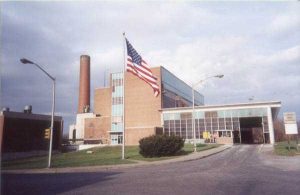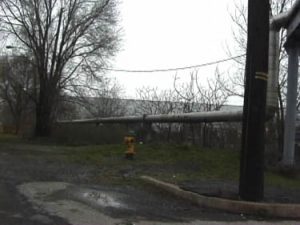Water System
1892 – The first water plant in Steelton was constructed by the Home Water Company. Before then, there was no filtration system. Some blame the typhoid outbreaks on the non-filtered water from the Susquehanna River.
1900 – The Borough bought the plant from H.W.C., making it an important addition to the municipality of Steelton.
1907 – The first filtration plant was built.
1908 – Due to the town’s population increase, the borough installed a larger water intake system.
As the town developed, it made many revisions and installations. Steelton has always prided itself in the quality of its water. The drinking water for Steelton comes from where the Juniata River meets the Susquehanna River. The intake is located in the middle of the water, to ensure the purest water before they run it through the filtering system. The water is pumped from the Juniata to the pumping station located on the edge of the Susquehanna River and where the West Side used to be. Before it is distributed throughout the Borough, it enters the filtering system nearby, in order for it to meet the Safe Drinking Water Act (SDWA) of 1974.
1993 – 98 – Many improvements, replacements, and installations were made during these years, including the laying of new pipes and lines at certain locations and the placing of twenty-five new fire hydrants throughout the Borough. There are also currently a few projects still in the planning process, such as a new water storage tank in the East End, more waterline replacements, and rehabilitation of a well at the filtration plant.
The Steelton Borough Authority appears to be very open and clear on the water quality for the residents of Steelton and others that are concerned. On the Water Consumer Confidence Report pages of the official Steelton Borough website, important information that is provided for the public’s awareness:
“Our goal is to provide you with high-quality, safe drinking water that exceeds every federal and state standard. As mandated by the Safe Drinking Water Act (SDWA), this “Consumer Confidence Report” details our water sources, the results of our water tests, and other information. You can count on
Steelton Borough Authority for Quality on Tap. Our results show it.”
Waste Disposal
1892 – The town officially established a garbage collection system.
Currently, York Waste Disposal, Inc., a subsidiary of Republic Services, is responsible for Steelton’s waste. Trash collection is one day per week, currently on Wednesday. Recycling a wide variety of materials is encouraged. There are also several trash clean-up days through the year. For more information on trash collection and recycling, please go to the Borough of Steelton’s Trash Page.
The Harrisburg Incinerator

The Harrisburg Incinerator in 2001. Photograph taken by Eric Wiediger.
The steel mill is in South Harrisburg, right on the north edge of Steelton. Even though there are many more disadvantages for Steelton, there is one advantage of the location of the Incinerator. It currently supplies some of the steam power for the steel mill. The steam is transported through a pipeline from the two facilities. Scroll down for a picture of the pipeline. Scroll down for an image of the steam pipe. For the disadvantages, the community is reminded daily of the incinerator’s disadvantages. As Frank Albert explains, dust particles containing hazardous chemicals often blanket Steelton:
“You always have dust from the incinerator. I can wash my car and some days and I come out and there’re fifty million particles of black dust all over, I mean, all over the cars.”
When asked if the residents complain about it to local governments, he stated:
“They complain and stuff about it, but then, it always comes down to politics…”
It is currently in operation, despite many violations and local activism. The environmental group Coalition Against the Incinerator –which commonly refers to the Incinerator as the “Dioxin Factory” — is still fighting to close it and lobbies through several ways, including community outreach programs, press releases, and pressuring the Harrisburg City Council. If you want to be on the mailing list of this group, email dioxinfactory@yahoogroups.com.
~~~~~~~~~~~~
Some of the general advantages and disadvantages to incineration:
Advantages of the incinerator:
- The reduction of municipal landfill space.
- The minimal alteration of daily activities for the consumers, haulers, and manufacturers.
- The economic benefits of the Harrisburg Incinerator include the plant’s own revenues, available jobs, and an increased tax base for the City of Harrisburg.
- A significant amount of energy is conserved through steam production and is used by several facilities in the area, including the present steel mill in Steelton.
Disadvantages of the incinerator:
- There is a low demand for operators and other workers on-site.
- Like landfills, incineration is not a long-term solution to our trash problem.
- Overall, it has been extremely expensive throughout its existence. The initial cost of building the facility, upgrading equipment and expensive repairs add up.
- To a degree, most incinerators burn hazardous materials that are in the municipal solid waste stream (i.e. batteries) such as arsenic, cadmium, lead, mercury, zinc, and chromium. Exposure to these heavy metals can cause cancer, liver disease, respiratory damage, and neurological disorders. The hazardous components are either released through air emissions or are collected in the ash. Since the burning process is not 100% efficient, products of incomplete combustion (PICs), especially dioxin and PCBs, are formed. These types of pollutants are the most hazardous of all emissions. In fact, air emissions of incinerators greatly increase the amount of pollutants in the atmosphere. The Environmental Protection Agency (EPA) reported “more than 80% of dioxin produced in the U.S. is from municipal and medical waste incinerator air emissions” (Toxic Alert, http://www.cqs.com/emswburn.htm). Pollution control equipment is required under current regulations of the Clean Air Act. However, the equipment only reduces, but does not eliminate, the toxins. The complexity and uncertainty in the science behind the long-term low levels of exposure of humans to the chemicals also increases the problems.

The steam pipeline that runs from the Incinerator to the steel mill. Image from DV video.
Sewage
1899 – The town began installing a sewage system.
1917 – A storm-intercepting sewer was constructed.
Throughout the 1920s, many more improvements were made due to an increase in environmental consciousness and economic stability.
1959 – The Steelton Borough Authority constructed a new sewage system.
1975 – The Borough of Steelton agreed to allow Swatara Township Authority to use its sewer system in service areas and other areas where needed.
1980 – The Steelton Borough Authority gave sewage system responsibility to the Borough of Steelton.
The current drainage area of the sewer system is about 2,400 acres, more than the acreage of the town itself. It is made up of combined sewer lines with the addition of two sub-drainage locations. It uses three pumping stations, which ultimately transport the sewage to the Wastewater Treatment Facility located within the City of Harrisburg. A recent project consisted of the installation of new pumping, control, and ventilation systems in each of the three pumping stations.
Paving
1906 – From Gibson Street to Mohn Street, the Borough first layed rectangular wood blocks on Front Street. Later, the Harrisburg Railroad Company helped this paving process by adding wood blocks between the trolley tracks on Front Street.

Paving Front Street in 1906 with wood blocks. Photograph from Stop, Look, Listen: Steelton, Pennsylvania.
1911 to 1914 – Second, Pine, Harrisburg, and other roads were paved.
1926 – The Central Construction Company began to repave and curb Front Street with concrete, while numerous other streets were paved with asphalt–on a concrete base.
1998 – 2001 – The town continued to keep their roads smooth and safe by repaving 50 percent of the streets in the Borough.